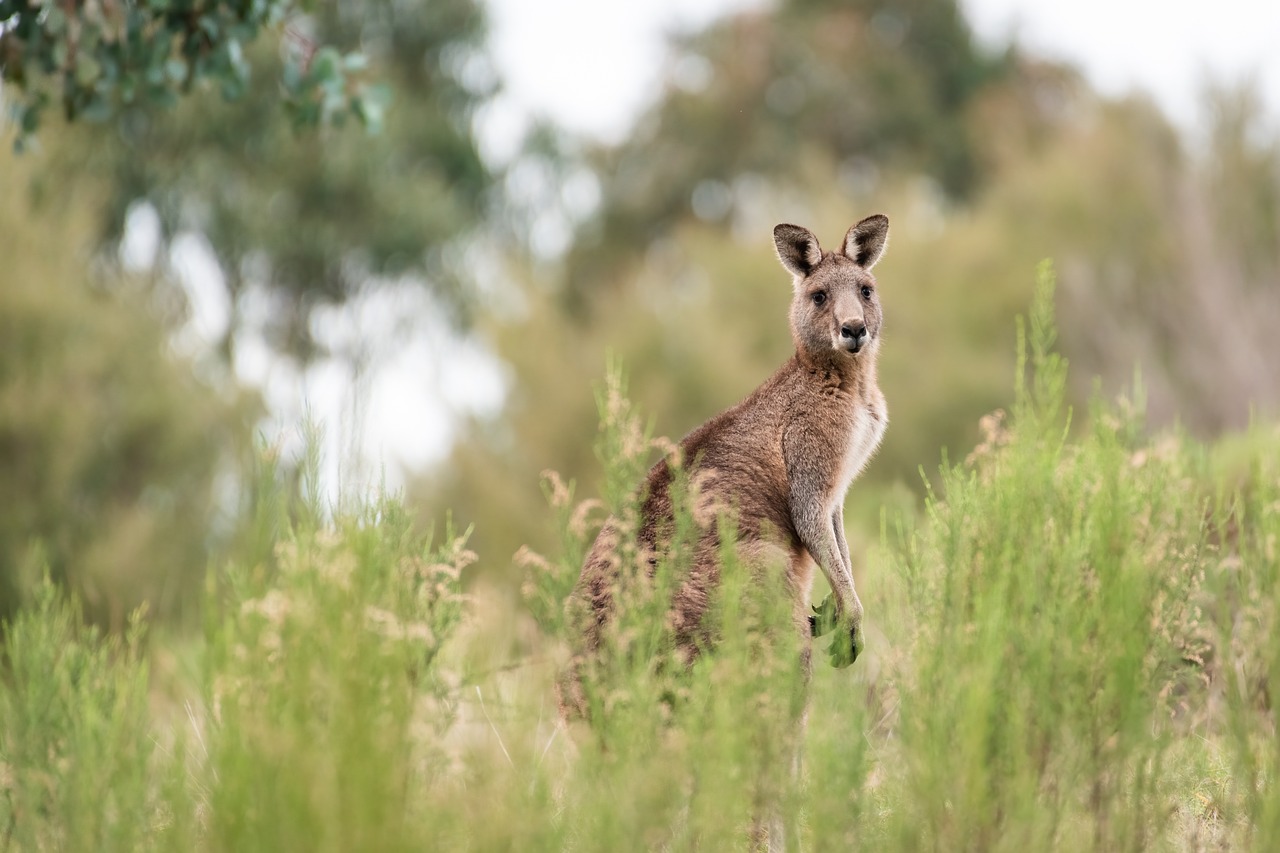- Kangaroos are marsupials native to Australia and are known for their powerful hind legs and distinctive hopping behavior.
- They are the largest marsupials in the world and belong to the Macropodidae family, which means “big feet.”
- There are four main species of kangaroos: the red kangaroo, eastern grey kangaroo, western grey kangaroo, and the wallaroo.
- Kangaroos have a unique reproductive system, where females have a forward-facing pouch in which they carry and nurse their young, called joeys.
- The kangaroo’s powerful hind legs allow them to travel long distances with efficient hopping, reaching speeds of up to 56 kilometers per hour (35 mph).
- Male kangaroos are called bucks, while females are referred to as does, and the young are called joeys.
- Kangaroos are herbivores, feeding primarily on grasses, shrubs, and leaves.
- They have a complex digestive system that allows them to extract maximum nutrition from their fibrous diet.
- Kangaroos can go for long periods without water, obtaining most of their moisture from the vegetation they consume.
- The kangaroo’s tail serves as a balancing tool while hopping and can also be used as a powerful weapon for defense.
- Kangaroos have a highly developed sense of hearing and can rotate their ears independently to locate sounds.
- They have a keen sense of smell and use their nose to detect food sources and potential dangers.
- Kangaroos are capable of leaping over obstacles and can clear distances of up to 9 meters (30 feet) in a single hop.
- Kangaroos have a unique reproductive strategy called embryonic diapause, where the female can delay the development of a fertilized egg until environmental conditions are favorable for survival.
- A kangaroo’s tail acts as a useful counterbalance, enabling them to maintain balance while hopping at high speeds.
- Female kangaroos have the ability to pause or extend the development of their embryos until they feel it is the right time to give birth.
- The muscles in a kangaroo’s legs work like built-in springs, storing and releasing energy with each hop.
- Kangaroos have excellent vision, with a wide field of view, allowing them to detect predators from different angles.
- Some kangaroo species, like the red kangaroo, can grow up to 1.8 meters (6 feet) tall, making them the largest marsupials.
- Kangaroos are social animals and live in groups called mobs, consisting of females, their offspring, and a dominant male.
- Kangaroos have a unique form of locomotion called pentapedal movement, where they use their tail as a fifth limb while grazing or walking slowly.
- Kangaroos are known for their ability to leap over fences and obstacles, making them skilled escape artists.
- Male kangaroos engage in boxing matches to establish dominance and access to mates, using their powerful hind legs to kick and their forelimbs to strike.
- Kangaroos have a relatively small head in proportion to their body size, with large, round ears.
- They are capable swimmers and can navigate bodies of water when necessary.
- Kangaroos have a lifespan of around 6 to 8 years in the wild, but some can live up to 20 years in captivity.
- The kangaroo population is managed through controlled hunting and culling programs to maintain ecological balance.
- Kangaroos are important to the Australian ecosystem as they contribute to seed dispersal and vegetation control.
- They have specialized teeth for grinding tough vegetation, allowing them to efficiently process their diet.
- Kangaroos have a strong immune system and are resistant to many diseases and parasites.
- The kangaroo is a symbol of Australia and is featured on the country’s coat of arms.
- Kangaroos have a unique method of reproduction, with a short gestation period of around 30 to 40 days followed by a prolonged period of pouch development for the joey.
- Kangaroos are able to conserve energy by lowering their metabolic rate and body temperature during periods of food scarcity.
- They have a diverse range of vocalizations, including grunts, clicks, and hisses, used for communication within their social groups.
- Kangaroos are known to exhibit altruistic behaviors, such as warning others in the mob of impending danger.
- They have an excellent sense of balance, allowing them to maintain stability while standing or hopping on uneven terrain.
- Kangaroos can communicate using body language, such as posturing, tail movements, and ear positions.
- Some kangaroo species, like the tree kangaroo, are adapted to arboreal habitats and have the ability to climb trees.
- Kangaroos have specialized muscles in their legs and feet that help absorb the impact of landing while hopping.
- They are capable of surviving in a wide range of climates, from arid deserts to tropical rainforests.
- Kangaroos have a specialized chewing mechanism called “cyclic chewing,” where they grind their food in a sideways motion.
- Kangaroo meat is consumed in some regions and is considered a lean and healthy source of protein.
- The kangaroo’s fur is coarse and can vary in color, ranging from gray to brown, providing camouflage in their natural habitats.
- Kangaroos have been depicted in Indigenous Australian artwork for thousands of years, representing cultural significance and connection to the land.
- They have a complex social structure within mobs, with hierarchies and individual roles for different members.
- Kangaroos are adept at conserving water, and their kidneys are highly efficient at concentrating urine.
- Some kangaroo species, like the wallaroo, have the ability to reproduce at any time of the year, as they are not limited to specific breeding seasons.
- Kangaroos can cover long distances in search of food and water, using their powerful legs to travel efficiently.
- They have been studied extensively for their unique adaptations and ability to survive in challenging environments.
- Kangaroos are iconic animals that symbolize the beauty and diversity of Australian wildlife, captivating the imagination of people around the world.
Facebook Comments


































